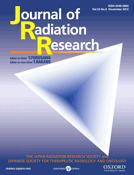
JOURNAL OF RADIATION RESEARCH
Scope & Guideline
Pioneering insights into the complexities of radiation effects.
Introduction
Aims and Scopes
- Radiation Biology and Mechanisms:
Research exploring the biological effects of radiation on cells and tissues, including mechanisms of radiation-induced damage and the cellular responses to radiation exposure. - Radiotherapy and Treatment Techniques:
Studies on various radiotherapy techniques, including intensity-modulated radiation therapy (IMRT), stereotactic body radiotherapy (SBRT), and brachytherapy, focusing on their efficacy, dosimetry, and clinical outcomes. - Diagnostic Imaging Innovations:
Investigation of new imaging technologies and techniques, such as magnetic resonance imaging (MRI), computed tomography (CT), and positron emission tomography (PET), to improve diagnostic accuracy and patient outcomes. - Radiation Safety and Risk Assessment:
Research addressing radiation safety protocols, risk assessment methodologies, and the evaluation of occupational and environmental radiation exposure. - Radiation Protection Strategies:
Innovative approaches and materials for radiation shielding and protection, aimed at minimizing radiation exposure to patients and healthcare workers. - Radiation Effects in Oncology:
Focused studies on the effects of radiation on various cancer types, including the evaluation of radiotherapy in combination with other treatments such as chemotherapy.
Trending and Emerging
- Radiomics and Artificial Intelligence in Radiotherapy:
An increasing number of studies focus on the integration of radiomics and artificial intelligence to enhance treatment planning and predictive modeling in radiotherapy, highlighting the role of machine learning in personalized medicine. - Combination Therapies in Oncology:
Research is trending towards exploring the efficacy of combining radiation therapy with other modalities such as immunotherapy or targeted therapies, aiming to improve patient outcomes and reduce side effects. - Advanced Imaging Techniques for Early Diagnosis:
There is a notable increase in the exploration of advanced imaging techniques, including PET/MRI and novel contrast agents, for the early detection and characterization of tumors. - Bioinformatics in Radiation Research:
Emerging themes in bioinformatics applications are being seen, particularly in analyzing large datasets for understanding radiation effects at the molecular level and predicting treatment responses. - Radiation-Induced Health Effects and Risk Assessment:
Heightened interest in studying the long-term health effects of radiation exposure, particularly in specific populations, is emerging, reflecting a growing concern for occupational and environmental safety.
Declining or Waning
- Basic Radiation Physics:
Research focusing on fundamental aspects of radiation physics appears to be declining, possibly due to a shift towards more applied research and clinical applications. - Environmental Radioactivity Monitoring:
Although studies on environmental radioactivity have been significant, there seems to be a waning interest in this area, possibly due to the saturation of available data and a focus on more immediate medical applications. - Historical Radiation Studies:
Papers that delve into historical radiation exposure and its effects have decreased, suggesting a move towards contemporary issues and immediate clinical relevance. - Non-Medical Radiation Applications:
Research on non-medical applications of radiation, such as industrial uses, has seen a decline, likely overshadowed by the growing emphasis on medical and therapeutic applications.
Similar Journals

Radiation Oncology Journal
Advancing cancer care through innovative radiation research.Radiation Oncology Journal, published by the Korean Society of Therapeutic Radiology & Oncology, stands at the forefront of cancer treatment research and innovation within the dynamic fields of oncology and radiology. With a focus on disseminating groundbreaking findings and advancements from 2012 to 2024, this journal aims to foster collaboration among researchers, clinicians, and educators dedicated to improving therapeutic techniques and patient outcomes in the context of radiation therapy. Recognized with a prestigious Q2 ranking in both the Oncology and Radiology, Nuclear Medicine and Imaging categories, it ranks 140th out of 333 in its Scopus category for Medicine Radiology and boasts a 58th percentile placement. While operating on a non-open access basis, the journal remains committed to providing valuable insights and updates to professionals in the field from its base in South Korea. As the landscape of cancer treatment evolves, the Radiation Oncology Journal continues to play a vital role in shaping research trends and enhancing the understanding of radiotherapy's role in comprehensive cancer care.
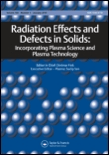
Radiation Effects and Defects in Solids
Transforming Understanding of Solid Material Behavior Under RadiationRadiation Effects and Defects in Solids is a prestigious academic journal published by TAYLOR & FRANCIS LTD that has been at the forefront of research related to the impacts of radiation on various solid materials since its inception in 1989. With an ISSN of 1042-0150 and an E-ISSN of 1029-4953, this journal serves as an essential resource for researchers and professionals in the fields of Condensed Matter Physics, Materials Science, and Nuclear and High Energy Physics. Despite its current categorization in the Q4 quartile across these disciplines, Radiation Effects and Defects in Solids remains critical for advancing knowledge of material responses to radiation, which is vital for applications in nuclear energy, space exploration, and radiation therapy. The journal publishes original research articles, reviews, and letters that provide insights into material properties, radiation dosimetry, and defect structures, fostering collaboration and innovation within the scientific community. As the field evolves, Radiation Effects and Defects in Solids continues to play a significant role in disseminating valuable research findings and keeping pace with emerging trends in materials science and radiation physics.
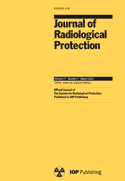
JOURNAL OF RADIOLOGICAL PROTECTION
Bridging research and practice in radiation protection.Journal of Radiological Protection, published by IOP Publishing Ltd, is a pivotal academic journal dedicated to advancing knowledge in the fields of radiology and radiation protection. Since its inception in 1988 and continuing through to 2024, this journal provides a platform for the dissemination of innovative research and critical reviews that explore the effects of radiation exposure on health and the environment. With an Impact Factor that places it among the Q3 category in Medicine, Public Health, Environmental and Occupational Health, as well as in Waste Management and Disposal, the journal is vital for professionals, researchers, and students keen on understanding the implications of radiological science. The Journal of Radiological Protection aims to contribute to improved practices and policies in radiation safety, making its findings essential for those involved in environmental health and public safety initiatives. Articles are accessible through various academic databases, ensuring widespread dissemination among the scientific community, thereby enhancing the journal's stature and influence in radiological research.
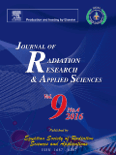
Journal of Radiation Research and Applied Sciences
Transforming understanding of radiation through rigorous scholarship.Journal of Radiation Research and Applied Sciences, published by ELSEVIER, is a premier open-access journal since 2013, dedicated to advancing the understanding and application of radiation research in various fields. With an ISSN of 1687-8507, this journal serves as a vital resource for researchers, professionals, and students engaged in the study of the physical and biological effects of radiation, radiation physics, and its applications in medicine and industry. Its rigorous peer-review process ensures the dissemination of high-quality research that meets the growing demands for innovative solutions in radiation science. By offering comprehensive access options, the journal promotes an inclusive approach to sharing knowledge with the global community. The Journal of Radiation Research and Applied Sciences stands out as a key platform for scholarly communication, fostering advancements that impact both theory and practice in the rapidly evolving landscape of radiation research.

Nuclear Physics and Atomic Energy
Connecting researchers to the world of nuclear discoveries.Nuclear Physics and Atomic Energy is a reputable open-access journal that focuses on the fields of nuclear physics and high-energy physics, providing a forum for researchers, professionals, and students to share their findings and advancements. Published by the Institute of Nuclear Research, National Academy of Sciences of Ukraine, this journal has been committed to disseminating knowledge since its inception in 2006, ensuring that scientific advancements remain accessible to a global audience. With an ISSN of 1818-331X and an E-ISSN of 2074-0565, the journal features a diverse array of articles that span the continued exploration and application of nuclear phenomena. Although currently categorized in the Q4 quartile for Nuclear and High Energy Physics in 2023, the journal is steadily working towards increasing its impact and engagement within the academic community. With a Scopus rank of #74 out of 87 in its category, it serves as a valuable resource for advancing crucial research in a vital scientific area. Researchers are encouraged to contribute their innovative studies to foster collaboration and knowledge sharing in this dynamic field.
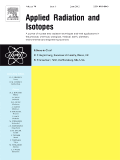
Applied Radiation and Isotopes
Connecting Researchers to the World of Radiation and IsotopesApplied Radiation and Isotopes is a premier journal dedicated to the dissemination of high-quality research in the fields of radiation and isotopes, published by PERGAMON-ELSEVIER SCIENCE LTD. With a commendable impact factor reflecting its respected standing, this journal ranks in the Q3 category within Radiation according to the 2023 evaluation, emphasizing its relevance in the scientific community. Operating out of the United Kingdom, it has been a crucial platform for innovation and knowledge sharing since its inception, covering a wide array of applications ranging from the medical to the industrial sectors. Researchers can access a wealth of articles through its online platform, although it currently does not offer open access options. Applied Radiation and Isotopes is thus an essential resource for researchers, professionals, and students aiming to stay abreast of the latest developments in radiation physics and isotopic applications, making impactful contributions to the field.
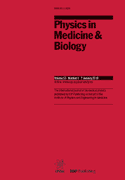
PHYSICS IN MEDICINE AND BIOLOGY
Innovating Healthcare Through Physics and BiologyPHYSICS IN MEDICINE AND BIOLOGY is a prestigious journal published by IOP Publishing Ltd, with a storied history dating back to 1956 and extending through 2024. This internationally recognized journal caters to the interdisciplinary fields of medical physics and bioengineering, making significant contributions to the research and development of advanced diagnostic and therapeutic technologies. It holds an impressive Q1 ranking in both Radiological and Ultrasound Technology and Radiology, Nuclear Medicine and Imaging categories, reflecting its critical role in disseminating high-quality research. With a significant focus on merging the principles of physics with advancements in medicine, PHYSICS IN MEDICINE AND BIOLOGY serves as an essential resource for researchers, professionals, and students alike, fostering innovation and enhancing collaboration in the healthcare sector. Although the journal is not currently open access, it maintains robust participation in the Scopus database, ranking #62 out of 333 in Radiology, Nuclear Medicine and Imaging and #17 out of 63 in Radiological and Ultrasound Technology, signifying its influence and reach within these disciplines.
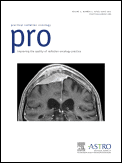
Practical Radiation Oncology
Transforming Research into Radiological PracticePractical Radiation Oncology is a premier journal published by Elsevier Science Inc., focusing on the critically important fields of Oncology and Radiology, Nuclear Medicine, and Imaging. With an ISSN of 1879-8500, this journal serves as an essential resource for professionals and researchers dedicated to advancing the practice and research of radiation oncology. Established in 2011 and continuing through 2024, it has quickly gained recognition, achieving a prestigious Q2 ranking in Oncology and an exceptional Q1 ranking in Radiology, Nuclear Medicine, and Imaging as of 2023. The journal, housed in New York, USA, provides a platform for innovative research and practical insights, aimed at enhancing therapeutic practices and improving patient outcomes. As part of its commitment to fostering scientific dialogue, it also features a range of articles, reviews, and clinical studies that cater to the diverse interests of its readers. Hard-copy availability combined with digital access ensures a broad reach for the latest advancements in the field.
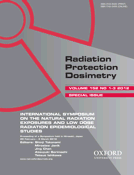
RADIATION PROTECTION DOSIMETRY
Empowering professionals through cutting-edge dosimetry insights.RADIATION PROTECTION DOSIMETRY is a vital academic journal dedicated to the field of radiation protection, published by Oxford University Press. With an ISSN of 0144-8420 and an E-ISSN of 1742-3406, this journal serves as a platform for groundbreaking research and developments in dosimetry, health physics, and radiation safety spanning over four decades since its inception in 1981. Recognized with a Q3 ranking in multiple categories including Medicine (miscellaneous) and Public Health, this journal plays a key role in disseminating important findings that inform policy, enhance practice, and promote the protection of both individuals and the environment from radiation hazards. While currently not available as Open Access, the journal's curated content is essential for researchers, professionals, and students dedicated to advancing knowledge in radiation protection and related areas. Interested readers will find the latest research trends, case studies, and reviews invaluable for their work and studies within this multidisciplinary domain.
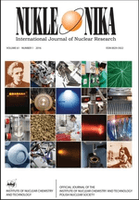
NUKLEONIKA
Exploring the Depths of High Energy PhysicsNUKLEONIKA, published by SCIENDO, is a leading open access journal that has been serving the scientific community since its establishment in 1968. Focused on the domains of Nuclear and High Energy Physics, Condensed Matter Physics, and Nuclear Energy and Engineering, this journal provides a platform for innovative research and technological advancements in a variety of interdisciplinary fields. With an impressive history of publications and a current Q3 ranking in several categories, including Safety, Risk, Reliability and Quality and Waste Management and Disposal, NUKLEONIKA is recognized for its significant contributions to scientific discourse. Open access since 2014, the journal ensures that all research outputs are freely available, facilitating broad dissemination and accessibility for researchers, professionals, and students alike. Located in the heart of Warsaw, Poland, NUKLEONIKA aims to inspire collaborative efforts and foster a deeper understanding of complex physical phenomena and their practical implications.